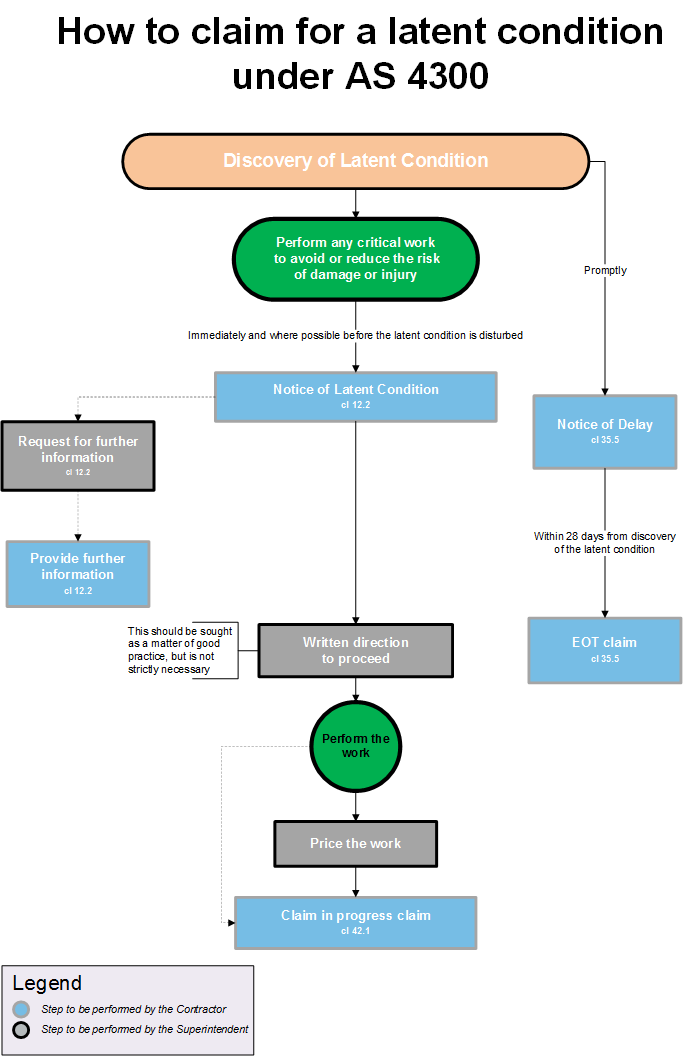This article explains how to make a claim for a latent condition under AS 4300. It includes a flowchart and form to explain the process.

1. What is a latent condition?
Clause 12.1 of AS 4300 defines a latent condition as:
“(a) physical conditions on the Site or its surroundings, including artificial things but excluding weather conditions, which differ materially from the physical conditions which should reasonably have been anticipated by the Contractor at the time of the Contractor’s tender if the Contractor had:
(i) examined all information made available in writing by the Principal to the Contractor for the purposes of tendering;
(ii) examined all information relevant to the risks, contingencies and other circumstances having an effect on the tender and obtainable by the making of reasonable enquiries; and
(iii) inspected the Site and its surroundings; and
(b) any other conditions which the Contract specifies to be Latent Conditions.”
Find out more about latent condition clauses here.
2. What should you do if you discover a latent condition?
If the latent condition poses an immediate safety risk or creates the risk of property damage, you should take steps to contain the risk so that those risks are mitigated or avoided wherever possible.
Otherwise, clause 12.2 of AS 4300 requires the contractor to give notice of the latent condition to the superintendent ‘forthwith and where possible before the Latent Condition is disturbed’.
This initial notice is fairly basic. The purpose at this point is to alert the superintendent to the problem. For this reason, the contents can be fairly brief. You should include details about the general nature of the latent condition and how you plan to deal with it in order to minimise the delay.
3. Request for further information
After receiving a notice of a latent condition, the superintendent may request that you provide further information in relation to the latent condition.
Clause 12.2 requires you to provide a response which includes details of:
“(a) the Latent Condition encountered and in what respects it differs materially;
(b) the additional work and additional resources which the Contractor estimates to be necessary to deal with the Latent Condition;
(c) the time the Contractor anticipates will be required to deal with the Latent Condition and the expected delay in achieving Practical Completion;
(d) the Contractor’s estimate of the cost of the measures necessary to deal with the Latent Condition; and
(e) other details reasonably required by the Superintendent.”
Clause 40.5 allows you to claim the costs of providing this information. If you wish to claim those costs, we suggest that you include a statement to this effect in your response, identifying the amount you intend to claim and how the amount has been calculated.
4. What to do if the superintendent does not respond to your initial notice?
Regardless of whether the superintendent requests further information from you in response to your initial notice, it is good practice to provide the superintendent with as much information about the likely time and cost effects of the latent condition before you embark on any remediation or rectification work.
Specifically, we suggest that you provide as much information as you can about the additional work, resources, time and costs necessary that will be required to deal with the latent condition, before you start work.
It is much harder for a superintendent (or principal) to deny a claim for additional time or cost in connection with a latent condition if you are transparent about the issues from the outset.
5. Are you entitled to costs for a latent condition?
Clause 12.3 entitles the contractor to a valuation where a latent condition causes the contractor to carry out additional work, use additional construction plant or incur extra cost (including but not limited to the cost of delay or disruption).
However, any costs you incur more than 28 days before the date you provided your notice of latent condition will not be recoverable. These are specifically excluded by clause 12.4.
6. When can you claim payment for a latent condition?
In most cases, you will be entitled to claim payment for a latent condition through your regular progress claims.
When you make your claim, it will be important to include sufficient information to enable the superintendent to assess the value of the work you have performed (and any delay costs you have incurred), if you have not already done so.
If you disagree with the superintendent’s treatment of your claim, the security of payment legislation may provide an interim remedy. (This will depend on where the project is located, as the operation of the security of payment legislation varies between states.) In any event, clause 47 of AS 4300 prescribes a method for resolving disputes on a final basis.
7. Delays caused by latent conditions
If the latent condition is likely to delay the project, you should give a notice of delay under clause 35.5 to ensure you are able to claim an extension of time (and delay costs) if needed. (Often, delay costs are included as part of the variation.)
To claim an extension of time, you will need to follow the process in clause 35.5. This means that you may need to give multiple notices in relation to the same latent condition to protect your position.
Resources
You can download a print-friendly PDF version of the latent condition flowchart above by clicking here.





